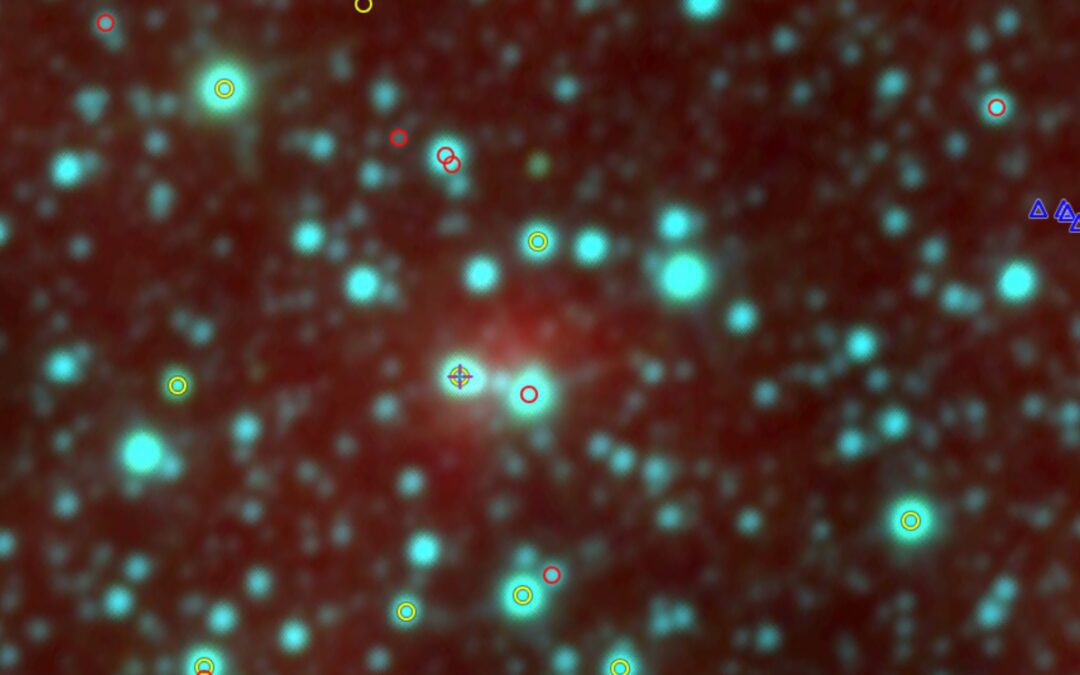Work on the Cygni 100 catalog is underway, complete with its own numbering system. An unexpected challenge in writing the catalog, however, is the seemingly endless amount of information found while looking up details for each double star. Sort of a nice problem to have. 😉
For example, the secondary component of the double star STTA 206 near the open cluster M 29 is an infrared bow shock star. What’s that? (I didn’t know either.) It turned up (by catalog number HD 229159) in a study titled Discovering Massive Runaway Stars with Infrared Bow Shock Nebulae: Four OB Stars Found in WISE presented at the 227th meeting of the American Astronomical Society in January 2016. Fast moving massive stars cause infrared nebulae to form in front of them like a wave is pushed up in front of a fast moving boat. More details are provided in this NASA article, also from January 2016.
The study utilized images from the Spitzer Space Telescope and Wide-field Infrared Survey Explorer (WISE). The image of STTA 206 above is from the WISE mission, accessed through SIMBAD. The star indicated by the cross hair is the primary A component and the star with the red circle just to the right is the B component, which is a super giant B spectral class star moving at -40 km/s that formed the infrared bow shock nebulae, seen as a reddish haze in the image.
STTA 206
20h22m +3912′
6.72/8.63 sep 43.7″ pa 254
Optical double star
Distance: 1786.57 / 5579.14 LY
Spectral Type: B8V / B1.5|Ib (less luminous super giant)
Color Index: -0.95 blue-white / +0.81 orange
White primary with deep yellow secondary at a comfortable distance. Primary brighter. Forms a quadrilateral with the guide stars for locating M 29. It’s also part of the Heart of Cygnus asterism. In the same field with M 29. Observation made with an APM 20×80 ED MS binocular from my urban yard on Wednesday, August 6, 2023.
The two stars are not physically related, only appearing near each other because they are on the same line of sight. The A component is 1786 light years distant, while the B component is 5579 light years distant, thousands of light years farther away.
Both are B spectral type stars, massive and somewhat rare, having shorter stellar lifespans (in the 100 million year range) because they are extremely hot and burn through their elements much more quickly than smaller, cooler stars like our own sun ( a G2 spectral class star with an expected life span of 10 billion years).
B spectral type stars typically have blue-white color indexes, but toward the end of their lives radiation from the core causes the outer envelope of the star to expand and cool, resulting in different color indexes. In the case of HD 229159 the result is an orange star, seen as deep yellow compared with the white color of the A component in my observation notes. The A component is at an earlier point in its life cycle. This is also reflected by the designation “8” following the “B” spectral class of the A star. Stars are ranked 0-9, 0 being the hottest and 9 being the coolest. Thus, the B component with a number of 1.5 is much hotter than the A component and aging more quickly. Both stars are probably(?) members of the Cygnus OB1 association.

This Sky Safari chart illustrates the triangle of 4th and 5th magnitude guide stars helpful for locating M 29 (P Cyg, 40, Cyg, and V2119). The 2nd magnitude yellow super giant star Sadr is the center of the northern cross asterism. The double star STTA 206 is just to the north of M 29 as shown above.
The observation above was made with a 20×80 binocular, but it might be possible to resolve STTA 206 with a mounted 10x binocular. I’m going to try that soon. Also, it is only one of a half dozen Cygni 100 doubles near M 29. As happens often, I can’t help thinking of the hundreds of times I have viewed M 29 and never once noticed this double star — a reminder of how much can be seen when one slows down and takes time to look carefully with a bit of planning beforehand, even in urban skies with “only” a binocular.

